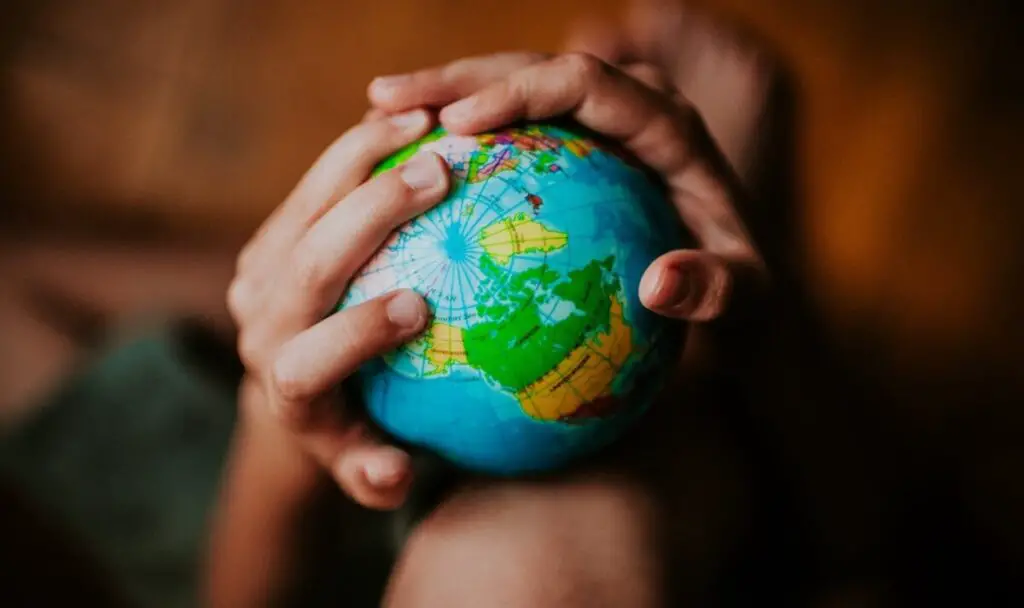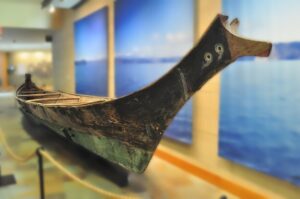Travel is a timeless pursuit that has entranced humanity since the dawn of our existence. From our ancestors’ nomadic wanderings in search of shelter from the elements and sustenance, to the grand voyages of discovery that expanded horizons, our travel through history is one of evolution, innovation, and most of all, the revelation of the origin of travel.
What does our travel through history tell us about our past, and what does it portend for our future? In this article, we embark on a thrilling journey through time, revealing the origin of travel and tracing the evolution of human travel from its earliest roots to its present-day form.
So, grab your passport, and let’s set off on a journey that promises to be equal parts enlightening and inspiring.
The Ancient Period

Human travel during the ancient period is marked by necessity rather than by the monetary, military or recreational reasons that have been travel’s greatest driving force throughout history.
The Prehistoric Era
Our hominid ancestors first began moving out of Africa around 2 million years ago in search of new lands and resources that were less determined by the seasons.
It is uncertain exactly when Homo sapiens began their migration out of Africa as the evidence is based on fossil records and genetic studies. But the most recent findings discovered at Mount Carmel, Israel, include a fossil of a mouth part, signs of stone tools, and animal remains. Analysis of the Homo sapien remains set the date back to at least 177,000 years ago which makes it the oldest Homo sapien found outside Africa.
Early Human Migration Patterns and Nomadic lifestyles
Early humans lived as nomads constantly in search of food and resources. Their societies were typically small and consisted of close-knit groups of individuals who were dependent on each other for survival. They shared skills and the resources available, such as edible plants and game animals.

The nomadic lifestyle allowed them to expand into new territories. Their more efficient body shape was perfect for striding over long distances as they found their way into all corners of the world. It is estimated that modern humans reached Europe around 45,000 years ago from different routes.
They spread into the Middle East and Central Asia about 35,000 years ago. They reached Australia between 40,000 and 50,000 years ago in canoes, and the Americas around 15,000 years ago. The land bridge of the Bering Strait that existed between Asia and North America (Alaska) during the Pleistocene Ice Age would have allowed humans to travel down through Canada and eventually into South America.
With migration came advanced technological advances. Colder climates required more protective clothing which in turn required new and more effective hunting techniques and stronger and more efficient hunting tools. The development of language around 50,000 years ago contributed to their ability to adapt to new habitats with more effective communication, planning and problem solving.
Ancient Civilisations and their Influence on Travel
The early settlements and first farmers emerged in various parts of the world around 10,000 to 12,000 years ago. This was a major turning point in the history of human travel and marks the beginning of civilisation as we know it today.
By domesticating plants and animals, early populations created more reliable and consistent food sources. A few of the earliest areas to create permanent settlements were:
- The Fertile Crescent in the Middle East where they grew wheat and barley.
- The Yellow River Valley in China which was perfect for growing rice.
- The Central Andes in South America where the cultivation of maize became widespread.
Trade Routes, Exploration, and Transportation Technology
With permanent settlements came more complex communities leading to the growth of cities. Trade routes opened and consequently the dissemination of ideas, religions, culture and language. The first roads in Sumer, in ancient Mesopotamia (present-day Iraq), along with the invention of the wheel, made it easier to exchange goods and engage in commerce with other cities and regions.
The Silk Road

It was first established during the Han Dynasty in China (206 BC–220 AD), when the Chinese began to trade silk and other goods with the peoples of the West. Rather than a single road, the Silk Road was a complex network of routes that evolved over more than a thousand years. Over the centuries, the Silk Road was a significant route for trading goods and sharing scientific, technological, and artistic ideas. It also helped the spread of Buddhism from India to China.
The Greeks and Romans
The Greeks and Romans were driven by a sense of exploration and a desire to expand their power. New and improved technologies helped them navigate unfamiliar terrain and transport people and goods over long distances. Some of these technologies include:
- Navigation and cartography: To travel long distances, ancient mariners and traders sought to chart the seas and map the lands they encountered.
- Shipbuilding: The need to build ships that could sail long distances meant that new types of vessels, improved sails, and more efficient propulsion systems needed to be developed.
- Metallurgy: The need to produce metal tools and weapons for trade and exploration led to advances in metallurgy, and new techniques for smelting and refining metal ores.
The Middle Ages
During the Middle Ages, the emergence of influential trading groups such as the Hanseatic League significantly impacted the growth of trade and commerce.
Expansion of Trade and Commerce
The Hanseatic League was a potent alliance of commercial and political power among Northern European merchant cities from the late 1200s to the early 1600s.
It controlled trade in the Baltic Sea between Europe and the wealthy cities of the East, such as Novgorod and Constantinople. The League’s monopoly over the trade of goods like timber, furs, and grain made it one of the wealthiest and most powerful organisations in Europe.
With the emerging competition from the Dutch and English trading companies in the 16th and 17th centuries, and the rise of new trade routes and centres, the Hanseatic League declined in the late 16th and early 17th centuries.
Growth of Cities – Urbanisation.
The growth of towns and cities, such as Venice and Genoa, meant a shift in where the trading hubs were located and the larger the towns grew, the greater their importance as centres of commerce became. Large cities soon became centres of politics and a melting pot of cultures, attracting people from all over Europe in search of work, wealth, education and opportunity.
As cities grew, so too did the need for reliable infrastructure. Roads and bridges greatly improved the efficiency of travel and the movement of goods.
Transportation Infrastructure
Transportation infrastructure during the Middle Ages was limited and often consisted of a patchwork of poorly maintained roads and bridges. This made travel and commerce difficult and dangerous. Nevertheless, there were some key developments during this period that helped to improve transportation and support the growth of trade and commerce.

- Despite the decline of the Roman Empire, the Romans’ well-built roads and extensive network remained in use during the Middle Ages.
- Rivers were also an important means of transportation during the Middle Ages, and many cities were established along the banks of major rivers to access them.
- The Rhine and Danube rivers were major trade routes that connected cities and facillitated the transportation of goods over long distances.
- Horse-drawn carts, that were used to transport goods and people over land, were relatively cheap and flexible.
- Donkeys, horses, and mules were commonly used as pack animals where wheeled carts could not go. Namely mountainous regions and areas with inadequate or unmaintained roads.
Religious Pilgrimages, the Crusades, and their Impact on Travel Technology
Religious pilgrimages, specifically those to Rome, Santiago de Compostela, and Jerusalem, were a major driver of travel during the Middle Ages.
With the threat of Islam spreading further north from Spain and the Middle East between the 8th and 15th centuries, Christianity experienced a wave of evangelism. Countries across Europe united in their effort to defeat the infidel and reclaim the Holy Land from the Muslims. Going on a pilgrimage was not just a religious act, but a form of military and political support for the religious Crusades.
Pilgrimages were also seen as a way for the traveller to experience different cultures and to interact with people from other parts of the world, as they are today. For many people, going on a pilgrimage was a once-in-a-lifetime experience, and they saw it as an opportunity to see new places and meet new people. In some cases, rulers used pilgrimages to demonstrate their power and influence by organising large-scale expeditions and offering protection to pilgrims.
New infrastructure such as improved roads and the building of hostels, inns and hospitals were built along the pilgrimage routes. Despite the availability of more protected, traveller-friendly paths, the dangers remained, making the experience thrilling and adventurous.
Myths, legends and superstitions grew out of these perilous ventures, which have become in themselves an attraction for the modern traveller.
The Renaissance and Modern Era
During the Renaissance (14th to 17th centuries) there was a renewed interest in travel for several reasons.
Technological Advancements and Industrialisation paved the way.
The technological advancements of the Modern Era suddenly made travel faster and easier than ever before.
- Many people became interested in the rediscovery of classical knowledge and wanted to see the ruins of classical civilisation.
- The advances in navigation and cartography made travel safer and more reliable, and allowed explorers to map the world more accurately.
- With the discovery of the New World, trade and commerce grew exponentially with bigger and faster ships and new trade routes. Sea travel took on a whole new aspect.
- Many people went on diplomatic missions to represent their country, while others went on religious pilgrimages to visit holy sites.
Besides the commercial advantages, it became more feasible for ordinary people to travel to distant and exotic lands.
Impact on Travel and Commerce
The Grand Tour
During the 17th and 19th centuries, young men and chaperoned women with more money than they knew what to do with, headed to Europe for the Grand Tour. This was an extended travel experience for young aristocrats and scholars looking for a cultural experience. The Grand Tour typically involved travelling throughout Europe, visiting major cities and cultural centres, and studying the arts, architecture, literature, and history. Countries included France, Italy, and Austria and could last several years.
The Industrial Revolution
The 18th and 19th centuries saw the beginning of an immensely significant new phase in the history of travel. The Industrial Revolution originated in Britain but rapidly extended to other regions of Europe and North America, ultimately transforming travel and transportation. Notable changes associated with this period include:
- The widespread adoption of steam engines and trains allowed for faster, more efficient and reliable transportation of goods and people.
- The increased ease and speed of travel which led to the growth of tourism, as people could now visit new places more easily and comfortably.
- The improvements in transportation helped to expand trade networks and allowed goods and people to move more freely between regions and countries.
These changes in travel and transportation helped to transform the world and lay the foundation for the modern era of globalisation.
Emergence of Leisure Travel and Tourism
The emergence of leisure travel and tourism in the modern era was a result of the Industrial Revolution and advances in transportation technology, but also in rising standards of living. The growth of the middle class meant people had more leisure time and disposable income and they began to seek out new experiences and destinations for entertainment and relaxation.

The widespread use of trains and the invention of the automobile around the turn of the 20th century suddenly made it much easier and more affordable for people to travel for pleasure.
And the availability of travel information, such as guidebooks and travelogues, also played a role in shaping travel culture, as people became more informed about destinations and travel options.
The Modern Era marked the beginning of leisure travel and tourism as a major industry.
How Travel Culture and Behaviour Changed
Today, the travel industry is one of the largest and most diverse industries in the world.
As a leisure pursuit, travel is gaining more popularity, with travel agents, tour operators, and media outlets promoting it as an opportunity to escape from the pressures of everyday life and discover new cultures and environments.
Unfortunately, the growth of the travel industry led to the rise of mass tourism as people have flocked to increasingly popular destinations. Particularly adversely affected from an ecological point of view, have been beaches, cities, and historical sites. Due to lack of planning and control, greed has led to overcrowding, water shortages, pollution, and destruction of fragile environments in a multitude of places around the globe.
State of Human Travel in the 21st Century
The pace of technological advance in the 21st century is moving faster than our ability to prevent the more detrimental effects of global mass tourism.
The Pace of Technological advance and the Effects
The widespread availability of the internet, information and digital technology has transformed travel, with online booking, navigation tools, and virtual experiences becoming increasingly common. It has never been more convenient or affordable to travel wherever and whenever we desire.
New Modes of Transportation and Globalisation
Innovations such as electric vehicles, high-speed trains, and commercial space travel have changed the way people travel and have opened new possibilities for mobility and exploration.
Advances in transportation technology, such as supersonic planes and hyperloops, have the potential to make travel even faster and more efficient, connecting people and places like never before.
Environmental Concerns
Tourism continues to grow at an alarming rate. But, despite the many benefits of travel and transportation, there are also significant environmental concerns associated with human travel in the 21st century.
Transportation is a major contributor to air and noise pollution, greenhouse gas emissions, and habitat destruction, and there are concerns about the impacts of these activities on the health of ourselves and the planet.
To address these concerns, themovement towards sustainable travel practices is growing. Minimising the environmental impact of travel and promoting conservation and preservation of natural resources is vital for our well-being.
Importance of Sustainable Travel Practices
Sustainable travel practices are increasingly important in the 21st century, as people seek to balance the benefits of travel with the need to protect the environment and conserve natural resources.
This can involve a range of practices, such as reducing carbon emissions, using public transportation, and supporting ecotourism initiatives that promote conservation and preservation.

Ecotourism has boomed in recent years as more people are looking for ways to travel sustainably. Many hotels and travel companies are promoting more sustainable practices that have a less negative impact on the environment and local communities. Some of these changes include:
- Sustainable materials in the construction of hotels and using renewable energy sources.
- Hotels with eco-friendly practices, such as reducing water and energy use, recycling, and using environmentally friendly products.
- Travel companies that offer packages which allow travellers to interact with local communities and support sustainable development projects.
- Travel companies that implement carbon offset programmes, allowing travellers to offset the carbon emissions from their flights by supporting renewable energy projects.
Conclusion
And so, we come to the end of our travel through history, the origin of travel and its evolution. From our humble beginnings as nomadic wanderers to the technological marvels of today, the story of human travel is one of constant innovation and exploration. It has been a journey that has taken us to the far corners of the world, revealing the rich tapestry of human history and culture.
As we reflect on what we’ve learned, it’s clear that travel has been a driving force in our evolution and has played a crucial role in shaping who we are today. But what of the future?
Will we continue to push the boundaries of travel, reaching new heights and venturing to new frontiers? Or will we seek to find balance in ways to travel sustainably and preserve our world for future generations?
The answer remains to be seen, but one thing is certain: the journey of human travel is far from over.
So, until we set off on our next adventure, let us take with us the lessons learned from our travels. Let us remember the wonders we’ve seen, the people we’ve met, and the experiences that have shaped us. For the journey of human travel is not just about reaching our destination, but about the journey itself, and the memories we create along the way.
FAQs
Q: How many eras have covered travel through history?
A: 4 eras have covered travel through history. The Ancient prehistoric period, the Middle Ages, the modern era, and the 21st century state of human travel.
Q: What are the advancements in technology and transportation as humans travelled through history?
A: Advancements in transportation include the development of transportation infrastructure, aerospace and space travel, and globalisation.
Q: What is the impact of human travel on the environment?
A: The impact of human travel on the environment includes efforts towards sustainable travel practices.

